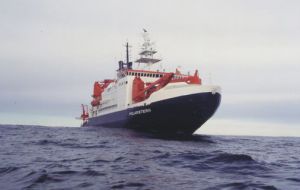MercoPress. South Atlantic News Agency
Southern Ocean climate fix remains afloat
 RV Polarstern
RV Polarstern Plans to curb climate change by using plankton to draw carbon dioxide into the world's oceans have been boosted.
A spectacular natural algal bloom in the Southern Ocean helped to "lock" carbon away into deep sea sediments, according to a study in Nature journal. But the amount of carbon stored was not nearly as high as some artificial "geo-engineering" schemes had predicted. Plans to "seed" plankton blooms by adding iron to oceans are strongly opposed by many green groups. The international research team behind the Crozex study say their findings have "significant implications" for plans to mitigate climate change. They come as scientists resume a controversial ocean fertilisation experiment in the Scotia Sea, east of Argentina. The Lohafex study had been suspended by the German government after environmental groups protested that it violates the terms of the UN Convention on Biological Diversity. They fear that adding iron to oceans may damage ecosystems. Ocean commotion Using algae as a "biological carbon pump" has been touted as one of the more promising "geo-engineering" schemes for mitigating global warming. Plankton act as a natural sponge for carbon dioxide - drawing the greenhouse gas down out of the atmosphere and into the sea. When plankton die, they sink to the bottom of the ocean, locking away some of the carbon they have absorbed. Experiments suggest that "seeding" oceans with iron can stimulate the growth of plankton - particularly waters which are rich in nutrients. But exactly how much carbon sinks to the sea floor, and how long it remains locked away, is still unknown. In the Crozex experiment, an international research team sailed to the Crozet Islands, in the Southern Ocean, about 2,200km (1,400 miles) southeast of South Africa. These waters experience a spectacular annual plankton bloom the size of Ireland, 120,000 sq km (46,300 sq miles) fertilised by iron naturally supplied from the islands' volcanic rocks. The researchers used sediment traps to follow the passage of carbon from the sea surface to the ocean floor. They found that seawater and sediment samples taken directly beneath the bloom were two-to-three times richer in carbon, compared to samples from a nearby ocean region which was rich in nutrients, but not in iron. "Our results have significant implications for proposals to mitigate the effects of climate change through purposeful addition of iron to the ocean," said lead author Professor Raymond Pollard, of the National Oceanography Centre, Southampton. "Our findings support the hypothesis that increased iron supply...may have directly enhanced carbon export to the deep ocean. "[However] our estimate of carbon sequestration for a given iron supply still falls 15-50 times short of some geo-engineering estimates." Next steps"This is a significant result," said Professor Peter Burkill, director of the Sir Alister Hardy Foundation for Ocean Science, Plymouth (SAHFOS). "It suggests that ocean iron fertilisation might work for reducing atmospheric CO2 through export of carbon into the ocean's interior. "But the next step from natural experiments to artificial ones is crucial. "We now need to know what the ecological impacts of artificial fertilisation experiments are." Many scientists doubt whether adding iron artificially will ever seed plankton blooms as successfully as natural iron. To test the technique, the German government has just re-authorised one of the largest ocean fertilisation experiments to date. The Lohafex expedition had been suspended, after concerns that it violated the terms of the Convention On Biological Diversity. But researchers on board the vessel RV Polarstern have now begun seeding six tonnes of iron sulphate over 300 square kilometres of the Scotia Sea, east of Argentina. "As this paper shows, much larger amounts of iron are being added daily by natural processes around the Crozet Island," said Professor Andrew Watson, University of East Anglia. "And that doesn't seem to have done the Antarctic ecosystem any harm." Crucial experiment"Legitimate experiments like [Lohafex] are crucial to learning more about the effects of iron fertilisation," said Dr Gary Fones, University of Portsmouth, who was part of the Crozex team. "They will help scientists evaluate the merits of such a scheme." However, the environmental impact of Lohafex was questioned by Kristina Gjerde, high seas policy advisor, the International Union for Conservation of Nature (IUCN). She said: "The fundamental question remains, should this activity be allowed to proceed unregulated? "I am not against research in this area; however, it should follow internationally agreed rules and procedures. "The Convention on Biological Diversity's call for a defacto moratorium on ocean fertilisation reflects the will of the international community that this activity should not proceed until certain basic requirements have been satisfied. "The government ministries that authorised the Lohafex experiment did not comply with the rules for [environmental] impact assessments as they currently exist under the London Convention [on the Prevention of Marine Pollution]." (BBC)




Top Comments
Disclaimer & comment rulesCommenting for this story is now closed.
If you have a Facebook account, become a fan and comment on our Facebook Page!